Last Friday, I was privileged to welcome students from the College for Creative Studies in Detroit to the Special Collections Library. As part of a class on exploring the book, attendees were preparing for an assignment to create a one-of-a-kind artists’ book. The instructor had asked me to find examples of unusual artists’ books with interesting structures, offering me an opportunity to explore new dimensions of Special Collections’ artists’ book holdings.
Artists’ books are difficult to define, as they encompass a staggering variety of forms and approaches to content, bleeding into the realm of luxurious fine press works on one end of the spectrum, into the world of zines on the other, and sometimes stretching the concept of “book” so far as to raise the question of whether some works might be better understood as sculpture. However, in general terms, the defining characteristic of the artists’ book is that it is an artwork in codex or related form (whether one-of-a-kind or a small edition) over which an artist exercises control over the choice of materials, content, layout, and design.
Perhaps the most traditionally book-like of the examples I selected for this class are two works by retired U-M book conservator, scholar, and artist Julia Miller: Stone Journal: Some Life and Rowing in Eden. Stone Journal: Some Life (1998) features text and illustrations collaged onto handmade paper, bound with exposed supports in clay covers fired with zinc oxide.
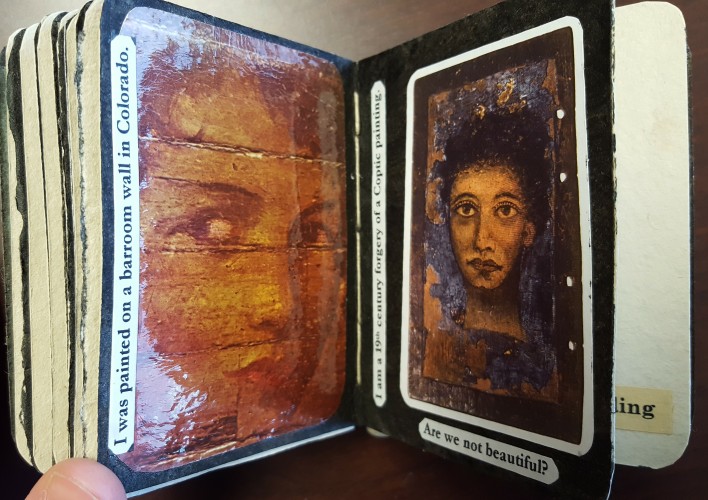
Julia Miller, Stone Journal: Some Life ([Ann Arbor, MI: Julia Miller], 1998). Special Collections N7433.4 .M55 S76 1998.
Stone Journal: Some Life incorporates the book’s housing into the artwork’s concept - in the photograph below, you can see the exposed clay boards nestled into its clamshell box, opposite a Magic: The Gathering card for “Stonehands | Enchant Creature,” reading “Trust in the power of stone. Stone is strong; stone shatters swords; stone breaks bones. Trust in Stone.”
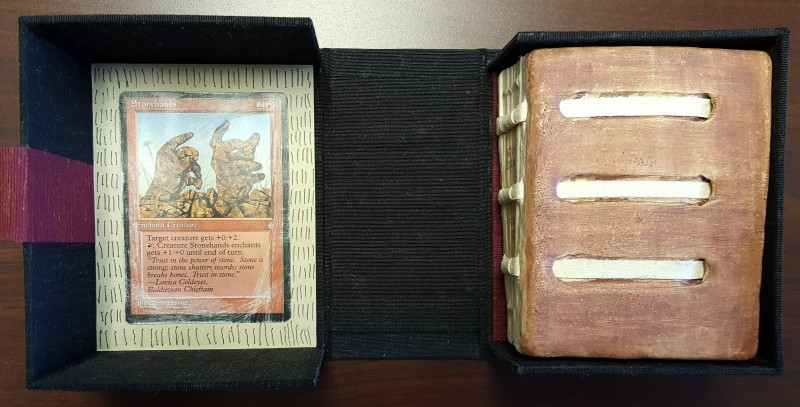
Julia Miller, Stone Journal: Some Life ([Ann Arbor, MI: Julia Miller], 1998). Special Collections N7433.4 .M55 S76 1998.
Miller’s artist’s statement for Rowing in Eden (2006) gives a detailed description of its design: “ten paired quotations from the poets Sappho and Emily Dickinson, laser printed on Somerset text [paper]. Each section of quotations is preceded by a mono-print and each print/text section is wrapped in a fold of rust-colored Lokta paper. The sections are attached into a cover of kangaroo leather with tackets made of waxed linen cord; the cover is lined with modern mud papyrus. The cover has a flap extension from the lower cover, and two wrapping bands decorated with laced strips of the same leather as the cover.” The different sizes of the orange and rust-red papers used in the text block, and the paler papyrus and leather of the wraparound cover create a complex layering that focuses the eye on the small black and white monoprints and the excerpted poetry that form the textual content of this book.
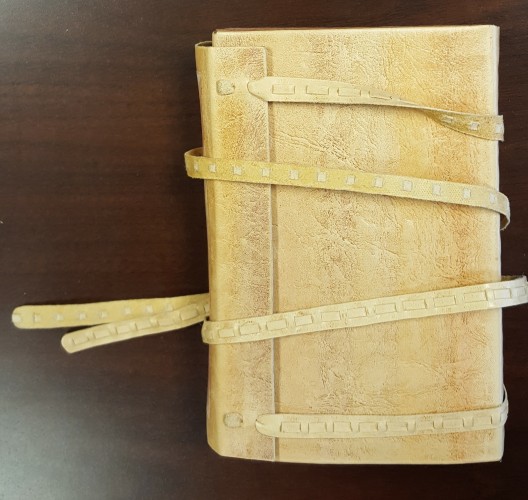
Julia Miller, Rowing in Eden ([Ann Arbor, MI: Julia Miller], 2006). Special Collections N7433.4 .M55 R688 2006.
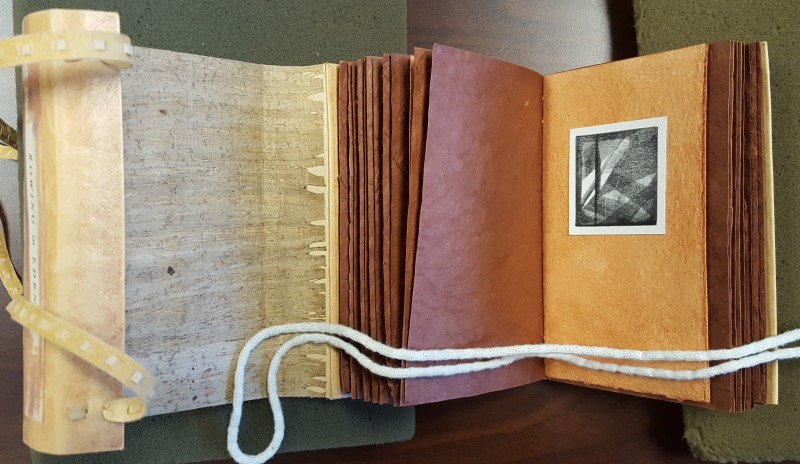
Julia Miller, Rowing in Eden ([Ann Arbor, MI: Julia Miller], 2006). Special Collections N7433.4 .M55 R688 2006.
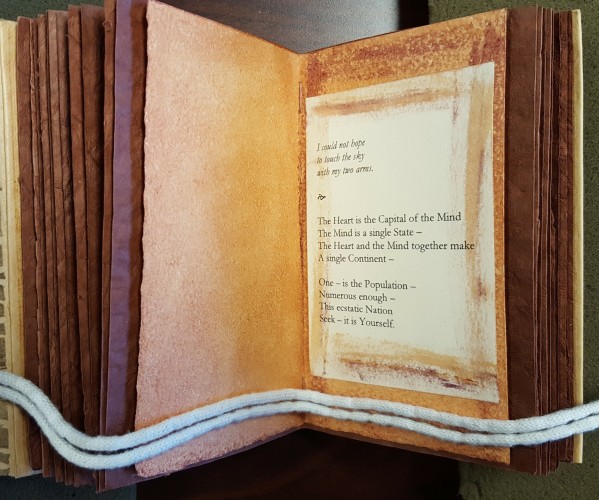
Julia Miller, Rowing in Eden ([Ann Arbor, MI: Julia Miller], 2006). Special Collections N7433.4 .M55 R688 2006.
A very different work, but one also inspired by Emily Dickinson, is Slant of Light = Sesgo de Luz (1998), designed by Rolando Estévezand published by Ediciones Vigía in Matanzas Cuba. Taking its title from a Dickinson poem that begins “There’s a certain Slant of light, / Winter Afternoons - / That oppresses, like the Heft / Of Cathedral Tunes -,” Estévez’ design embeds a volume of selected poems within a house-shaped enclosure featuring Emily Dickinson’s portrait on its roof. Inside is not only the book of poems - composed of mimeographed reproductions of typescripts with pictorial borders and drawings on coarse brown paper - but also a tree, moon, stone, and a blue tulle sky.

Emily Dickinson, Slant of Light = Sesgo de Luz (Matanzas, Cuba: Ediciones Vigia, 1998). Selection, translation, and prologue by Jorge Yglesias; Design and drawings by Rolando Estévez. Special Collections N7433.4 .E3 D5418 1998.
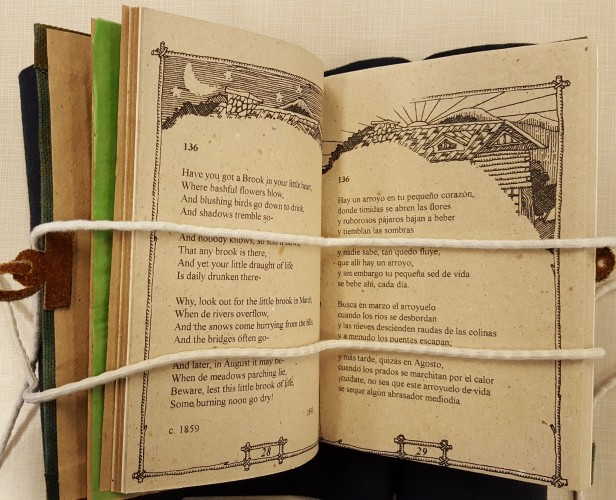
Emily Dickinson, Slant of Light = Sesgo de Luz (Matanzas, Cuba: Ediciones Vigia, 1998). Selection, translation, and prologue by Jorge Yglesias; Design and drawings by Rolando Estévez. Special Collections N7433.4 .E3 D5418 1998.
One of the books that students returned to over and over again during their hour of free exploration, was Karen Kunc’s Prayer Book (1992). Its ovoid cherrywood case opens to display an egg shaped “book,” whose carved, cherrywood pages are decorated with gold leaf and acrylic. Housed within recesses in the pages are stones and other found objects. Kunc’s work is a lovely example of how artists’ books can engage the senses and create an often in-depth “reading” experience through primarily visual, rather than textual, elements. .
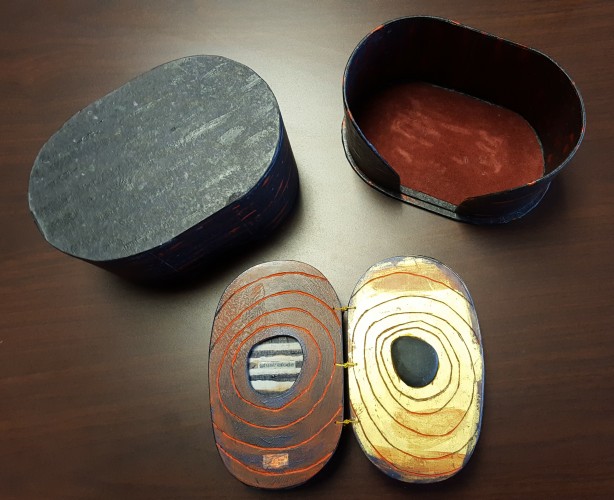
Karen Kunc, Prayer Book ([Nebraska?: Karen Kunc,] 1992). Special Collections N7433.4 .K84 P73 1992.
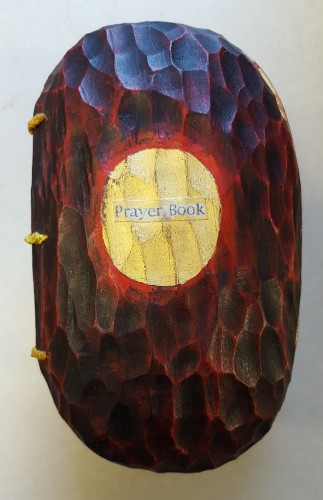
Karen Kunc, Prayer Book ([Nebraska?: Karen Kunc,] 1992). Special Collections N7433.4 .K84 P73 1992.
Students were also fascinated by two recent acquisitons that move away from the multi-page codex format, but draw on the tradition and techniques of pop-up books. Ashima and Bamei, Peach Blossom in a Forest are from Colette Fu’s series “We are Tiger Dragon People,” which her artist’s statement describes as, “photographic pop-up books of the ethnic minorities of Yunnan Province China.” Each consists of a single opening featuring an elaborate pop-up structure, printed with Epson ultrachrome pigment ink. While the pop-ups themselves contain minimal text, Fu’s artist's statements describe the context and inspiration for her works:
“Bamei means ‘cave in the forest’ in Zhuang language. Tao Yuanming, the Eastern Jin Dynasty (317-420) poet, wrote of an isolated Peach Blossom Valley where people lived a simple pastoral life...To the Chinese, the peach blossom symbolizes luck, love, and longevity, and to some - immortality.”
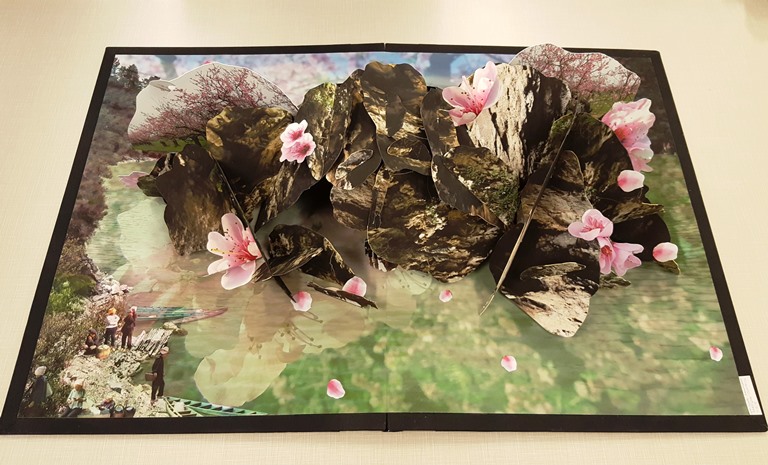
Colette Fu, Bamei, Peach Blossom in a Forest ([Philadelphia]: [Colette Fu], 2015). Edition of 10. Special Collections N7433.4 F8 B36 2015.
“The Sani live in and around Stone Forest, and are a subgroup of the Yi...Their legend of Ashima is sung from generation to generation and is an inspiration for Sani women today who refer to it as ‘the song of our ethics.’ Ashima was a young Sani girl engaged to be married to (her cousin) Ahei. Azhi, the son of the village leader, tried to force her to marry him. Azhi unleashed a trio of tigers to kill Ahei[,] who killed the tigers with arrows and escaped unscathed. But when Ashima and Ahei were playing by a river, Azhi generated a flood and Ashima drowned and turned into river stones. Her words are echoed through the forest: ‘I will never disappear even as the sun and cloud disappear, my soul and my sound will exist till the end of time.’"
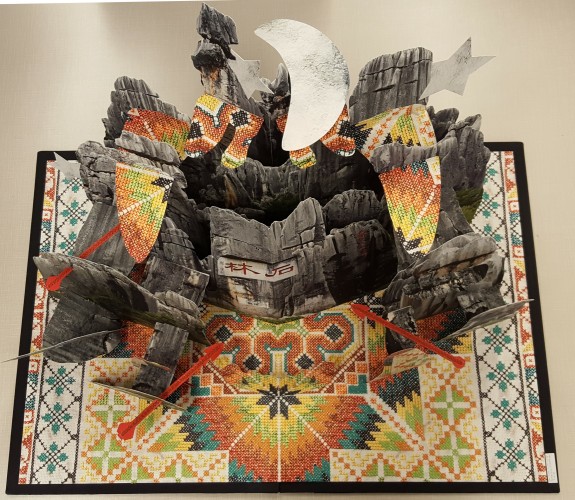
Colette Fu, Ashima ([Philadelphia]: [Colette Fu], 2014). Edition of 10. Special Collections N7433.4 F82 A22 2014.
These and more than 500 other artists’ books may be requested for use in the Special Collections Library Reading Room. To see a complete list of Special Collections’ holdings in this area, go to Mirlyn Advanced Search and search for SUBJECT “Artists’ books,” limiting the location to “Special Collections Library.”